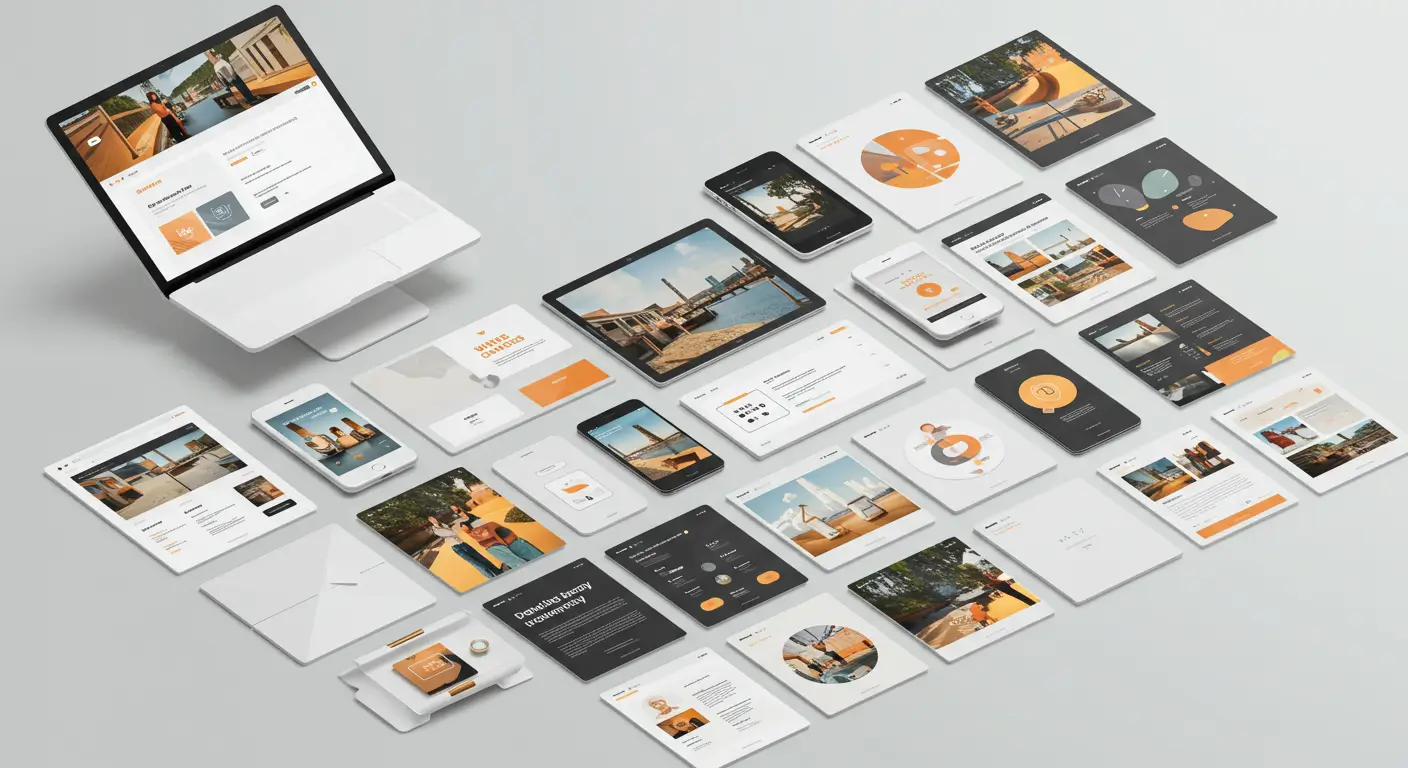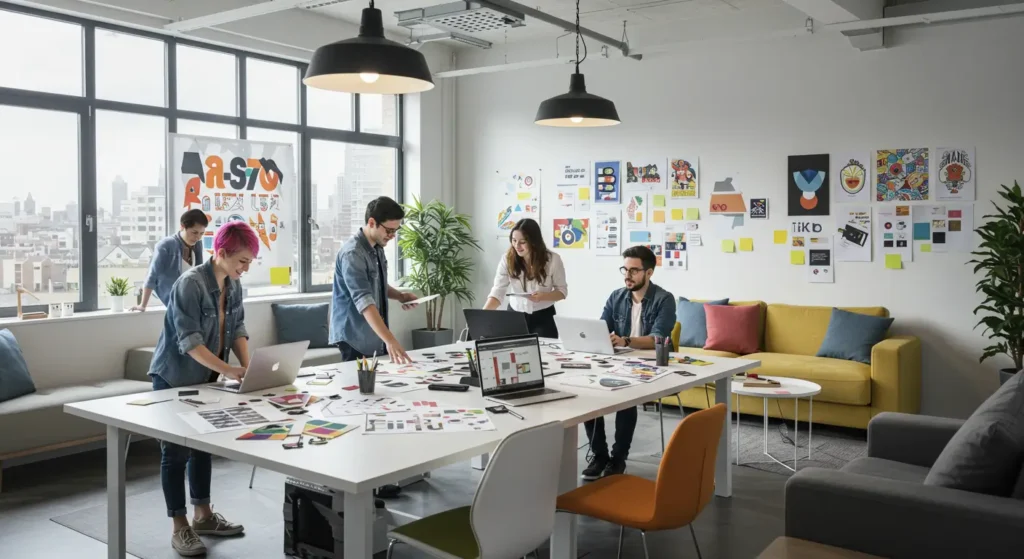
Professional Creative Agency Website Designs
Why Your Creative Agency Needs a Professional Website
First Impressions Matter
In today’s digital age, your website is often the first point of contact between your agency and potential clients. The moment they land on your page, their judgment is formed within seconds. A professional website ensures that this first impression is memorable and aligns with your brand identity. If your website is sleek, visually appealing, and easy to navigate, it will convey that you’re a competent and forward-thinking agency. In contrast, a poorly designed website can turn potential clients away, harming your agency’s reputation. User experience (UX) plays a key role here; it’s essential that visitors can quickly find the information they need while enjoying a smooth, engaging experience.
Building Trust with a High-Quality Design
A high-quality website design reflects your agency’s level of credibility and professionalism. When clients browse your site, they are not just looking for services—they’re assessing whether you can deliver the level of quality they expect. A modern, polished website filled with quality imagery, seamless navigation, and detailed information shows that your agency invests in its own image. Trust is a critical component in the decision-making process. If a potential client is impressed by the professionalism of your site, they’re more likely to trust you with their project. This establishes a strong foundation for future business relationships and successful collaborations.
Standing Out in a Competitive Market
The digital marketplace for creative agencies is incredibly competitive. Every day, hundreds of agencies are competing for the attention of the same pool of clients. This is where differentiation becomes crucial. A well-crafted website allows your agency to showcase its unique creative marketing strategies, setting you apart from the rest. Whether it’s through innovative design elements, compelling case studies, or a strong portfolio, your website can demonstrate exactly what makes your agency stand out. If your site reflects your unique approach to creative solutions, you will attract clients who resonate with your vision and style. In the crowded world of creative agencies, your website is your opportunity to shine and capture attention.
Connecting with Your Audience Effectively
Your website serves as a platform to engage with your target market. It’s essential to design your website not just for functionality, but with your audience’s needs in mind. By tailoring content and design to your target audience, you create a personalized experience that fosters connection. Whether it’s a compelling blog post, insightful case studies, or interactive features, engaging content keeps visitors on your site longer, which boosts your chances of converting them into clients. A professional website provides the right tools to connect effectively with your audience, providing them with value and a reason to trust your agency’s expertise.

Key Elements of a Professional Creative Agency Website
User-Centric Design
At the heart of any professional creative agency website is a user-centric design. This approach prioritizes the needs and behaviors of your website’s visitors, ensuring they have a seamless and intuitive experience. Intuitive navigation is a critical aspect of user-centric design—visitors should be able to find the information they’re looking for quickly and easily, without feeling lost. A well-structured layout and clear calls to action (CTAs) help guide users through the site effortlessly. Additionally, responsive design ensures that your website looks and functions flawlessly across all devices—whether it’s a desktop, tablet, or smartphone. By focusing on the user, your website will foster a positive experience that encourages visitors to engage and return.
Visual Design That Tells Your Brand Story
Your website is more than just a digital business card; it’s an opportunity to communicate your agency’s brand story through design. Design aesthetics play a vital role in expressing your agency’s personality and values. From color schemes and typography to imagery and layout, every element should reflect your unique identity. Well-crafted branding elements—such as logos, custom illustrations, and carefully selected images—help strengthen brand recognition and tell your story in a compelling way. A visually cohesive website that aligns with your agency’s branding will leave a lasting impression on potential clients and build trust in your creative abilities.
Conversion-Focused Features
A professional creative agency website isn’t just about looking good—it’s also about driving business results. That’s where conversion-focused features come in. To turn visitors into leads, your website should include elements like strategically placed calls-to-action (CTAs) that encourage users to take the next step, whether it’s scheduling a consultation, signing up for a newsletter, or requesting a quote. Another key feature is the integration of lead generation forms that make it easy for potential clients to reach out. By focusing on conversion optimization, your website will become an effective tool for turning passive visitors into active clients.
Content That Engages and Converts
Your website’s content should do more than just inform—it should engage and convert. A solid content strategy ensures that all elements of your website, from your homepage to your portfolio, are designed to speak directly to your target audience. Content should resonate with their pain points, needs, and desires. Incorporating a blog into your website is an excellent way to share valuable insights, showcase your expertise, and provide ongoing value to visitors. A blog not only boosts your SEO efforts but also builds credibility with your audience, positioning your agency as an authority in your field. When well-executed, content becomes a powerful tool for keeping visitors engaged and converting them into long-term clients.

How to Ensure a Seamless User Experience on Your Website
Mobile-Optimized Design
With an increasing number of users browsing the web on mobile devices, mobile-optimized design has become a must. A responsive website adapts seamlessly to different screen sizes, ensuring that your site functions flawlessly on smartphones, tablets, and desktops. Adopting a mobile-first approach means designing your website with mobile users in mind first, then scaling it up for larger screens. This ensures that mobile users have an equally smooth experience as those on desktops, which is crucial for retaining visitors. A mobile-friendly design not only enhances usability but also improves your SEO rankings, as search engines like Google prioritize mobile-optimized websites in their search results.
Fast Loading Times and Performance
Website speed is a critical factor in user experience. A slow-loading website can frustrate visitors, leading them to abandon your site before even engaging with your content. Page speed directly affects both user satisfaction and your SEO rankings. Optimizing your website for fast performance ensures that pages load quickly, regardless of device or location. Compressing images, leveraging browser caching, and minimizing the use of heavy scripts are just a few techniques that can improve loading times. A fast, efficient website reduces bounce rates, enhances user retention, and contributes to better conversion rates, giving users the seamless experience they expect.
Clear Calls to Action (CTAs)
A clear call to action (CTA) is vital for guiding users towards taking the next step, whether it’s contacting you, downloading a resource, or purchasing a service. A well-designed CTA stands out on your page and tells users exactly what to do. Whether it’s a button, a link, or a form, each CTA should be strategically placed to enhance the conversion rate. Clear, concise text that emphasizes benefits (“Get Your Free Consultation Now” or “Start Your Project Today”) is crucial for motivating users to act. When CTAs are placed correctly and designed to catch attention, they help direct the user’s journey through the site, creating an action-driven experience that ultimately leads to more conversions.
Streamlined Navigation for Ease of Use
Effective navigation is essential for guiding users through your website. If your visitors can’t find what they need quickly, they will likely leave. A streamlined navigation system ensures that users can access the most important sections of your site with ease. Organizing your content into clear, logical categories—along with a user-friendly menu and easy-to-use search features—helps create a smooth user journey. Each page should be just a click or two away from the main navigation, ensuring that visitors can access what they want without hassle. The simpler and more intuitive your navigation, the easier it will be for users to engage with your site, ultimately resulting in a better overall experience.
Best Practices for Creative Agency Website Layouts
Clean and Minimalistic Designs
One of the most effective design philosophies for creative agency websites is clean and minimalistic design. By embracing simplicity, you allow your content to shine without overwhelming visitors. A clutter-free design with plenty of white space gives your website a modern, professional look while enhancing user experience. Visitors can focus on the core message of your website without distractions. The key is to remove unnecessary elements and keep only what’s essential. This type of design also makes it easier for users to navigate your site, ensuring they don’t feel overwhelmed by information overload. Ultimately, a minimalistic approach makes your website both visually appealing and easy to use.
Visual Hierarchy and Balanced Layouts
Effective visual hierarchy is fundamental to guiding users through your website in a logical flow. It ensures that the most important content is placed where it will capture the most attention. By using design principles like size, color, and positioning, you can create a balanced layout that makes your website easy to read and navigate. For example, larger fonts or bold colors can highlight calls to action or key messages, while smaller text can be used for secondary information. Good visual hierarchy also improves readability, which is essential for keeping visitors engaged and reducing bounce rates. A balanced layout, where text, images, and other elements are proportionally distributed, makes the entire experience visually pleasant, making it easier for users to digest content.
Integrating Case Studies and Portfolio
For creative agencies, showcasing your work is crucial. Portfolio design is essential for displaying your agency’s capabilities, and integrating case studies is a powerful way to highlight your successes. A well-designed portfolio section not only displays your best work but also provides context for each project, demonstrating how you solved clients’ problems or achieved specific goals. Including client testimonials within case studies adds credibility and authenticity to your work, helping potential clients see the value you bring. Your portfolio should be easy to navigate, visually appealing, and organized in a way that highlights your best projects, making it easy for users to explore your expertise and experience.
Consistent Branding Across Pages
Consistency in branding is key to building trust and recognition across all digital touchpoints. Your website should reflect your brand guidelines at every level, ensuring a cohesive design across all pages. This includes consistent use of color schemes, fonts, logos, and imagery that align with your agency’s overall identity. A unified look not only enhances the professionalism of your site but also helps reinforce your brand message. Consistency across pages makes navigation easier, as visitors come to recognize your design elements and associate them with your agency. This cohesive approach ensures that your website feels like a seamless extension of your agency’s brand, fostering a sense of reliability and professionalism.
The Role of SEO in Your Creative Agency’s Website Design
Optimizing Your Website for Search Engines
A well-designed website is only effective if people can find it. SEO strategy plays a crucial role in driving organic traffic to your creative agency’s website. From the initial stages of design, it’s important to ensure your website is built with SEO in mind. This includes optimizing on-page elements such as title tags, meta descriptions, header tags, and URLs, as well as ensuring your site content is relevant, keyword-rich, and valuable to your target audience. Effective SEO not only helps your website rank higher on search engines like Google but also ensures that your site is accessible and user-friendly. By following SEO best practices, your creative agency can increase its visibility, attract more potential clients, and ultimately grow your business.
Importance of Mobile SEO
With more people accessing the web on mobile devices, mobile SEO has become a critical part of your website design. Mobile optimization isn’t just about having a responsive design that adapts to different screen sizes—it’s about optimizing the entire user experience for mobile users. Google places a high priority on mobile-friendly websites, and Google ranking is often influenced by how well your website performs on mobile. Slow loading times, poor navigation, and difficult-to-read text can drive users away and hurt your SEO performance. Ensuring that your website is mobile-optimized is essential for both user experience and SEO. A mobile-first approach helps improve your site’s rankings and keeps visitors engaged, no matter what device they are using.
Local SEO for Creative Agencies
As a creative agency, your potential clients may be looking for services in specific geographic areas. Location-based SEO is essential for helping your agency appear in local search results. By optimizing your website with location-specific keywords, creating location-based content, and ensuring your agency is listed on local directories, you can increase your visibility for local searches. One of the most effective ways to boost your local SEO is by setting up and optimizing your Google My Business profile. This allows your agency to appear in local search results, maps, and Google’s Knowledge Panel, giving you greater exposure to potential clients in your area. Local SEO is particularly beneficial for creative agencies that serve specific geographic regions or communities.
Ongoing SEO Maintenance
SEO is not a one-time task—it requires continuous monitoring and adjustment. Ongoing SEO maintenance is essential to keep your website optimized and competitive in search engine rankings. Regular SEO audits help identify areas of improvement, such as broken links, slow-loading pages, or outdated content. Additionally, tracking keyword performance and updating content based on new trends or client needs ensures that your website stays relevant. Regularly optimizing for keywords, adding fresh content, and keeping up with Google’s algorithm updates are all essential to maintaining strong SEO performance. By investing in continuous SEO efforts, your creative agency can stay ahead of competitors, attract consistent traffic, and drive long-term growth.


